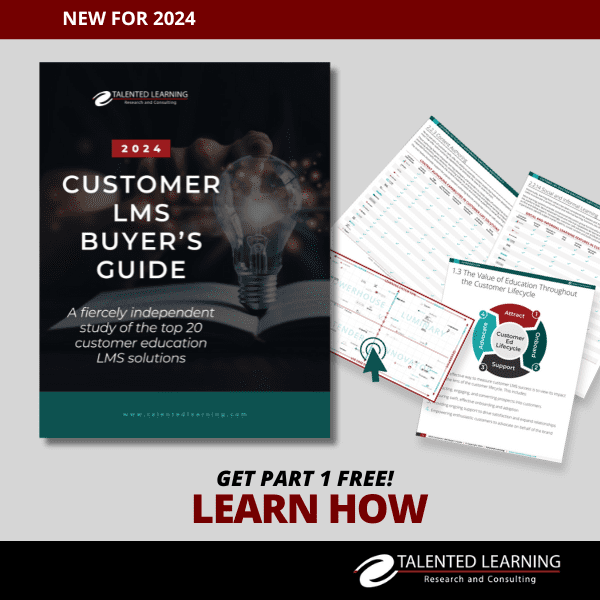
Supply chain training isn’t for the faint of heart. These partner networks are some of the most advanced ecosystems in the extended enterprise learning world, especially in the manufacturing space. It makes sense, because the audiences and technologies involved are often diverse and distributed, yet they must also operate in a highly integrated fashion.
So, where should you start? I recommend focusing first on understanding the people in your partner network. Who are they? What are their objectives? And how should they be contributing to your organization’s success?
For example, corporations typically rely on both internal and external sales channels to package, distribute and service their products. These are the table stakes that typically come to mind when we think of partner training. But many organizations include a variety of other essential players in their supply chain ecosystems.
What should you know about these various players and how they work together to drive product momentum? First, let’s look at 10 key partner audience types. Then let’s look at how training helps these partners improve business effectiveness and efficiency.
10 Key Supply Chain Audiences
1) Manufacturers – These companies are the center of gravity for any supply chain. They produce goods that are distributed through others in the ecosystem, such as wholesalers, resellers and cooperatives. They may also sell directly to end-user customers, as well.
2) Suppliers – Known as the first link in the supply chain, suppliers are essential because they source the raw materials that manufacturers use to produce goods. Typically, their goal is to minimize the time and cost involved in acquiring and delivering materials that meet manufacturing specifications.
3) Distributors – These organizations deliver a manufacturer’s products to the marketplace, along with support services that typically target a particular market segment or industry.
4) Wholesalers – These are intermediaries who make a profit by buying products in bulk and selling them in smaller quantities to other organizations.
5) Value-Added Resellers (VARs) – These companies resell products they’ve wrapped in solution services such as configuration, set-up, maintenance and training. For example, many IT shops resell Dell or Microsoft products by bundling them with a set of related professional services.
6) Retailers – Retailers are the ultimate front-line organizations that sell products and services to individual end-users or businesses. Retailers can represent a single brand (such as Apple stores), but most often represent many bands (such as hardware stores).
7) Franchise Partners – Franchising is a distribution method that extends a company’s reach by making it possible for others to license the brand identity, processes, procedures, products and/or services. For example, many McDonald’s stores are owned and operated by independent companies that pay franchising fees to McDonald’s corporation.
8) Buying Groups – These entities are comprised of smaller organizations that work together collectively to achieve the purchasing power of a larger organization. Buying groups are different from cooperatives, where each member owns a partial stake in the organization.
9) Cooperatives – A group of individuals or businesses, working together as member-owners to share distribution profits and costs. Often, co-ops are comprised of smaller organizations that join together to achieve economies of scale.
10) Affiliates – When one business purchases a minority stake in another, they become affiliates. These relationships are usually formed for strategic reasons. For example, they can help the affiliates gain or sustain a competitive advantage in R&D, production, distribution or other business functions.
Do you want deep comparative data on the world’s top 40 learning systems vendors? Check out our 2023 Corporate Learning Systems Market Update report – now available for purchase and download! GET DETAILS HERE
10 Ways to Apply Supply Chain Training
1) Onboarding Partners – Onboarding is the process of finding, selecting, negotiating and indoctrinating a supply chain partner. It can include training, along with other introductory activities, such as providing access to brand guidelines, signage and other promotional tools, as well as back-office functions that support the new relationship.
2) Certifying Partner Representatives – Research shows that partner representatives who are certified outperform those who are not. Ideally, certification is based on the completion of a predefined training path that aligns with the learner’s role in sales, service or another business function in the partner organization.
3) Certifying Partner Companies – Partner organizations typically employ multiple individuals who require training of some kind to properly represent or support a product. These companies can earn organizational certification by ensuring that a majority of individuals have completed role-based training certification. This helps ensure strong brand affinity and product knowledge, across the board.
4) New Product Rollouts – As manufacturers introduce and improve products, it’s important to educate everyone in the supply chain about the product itself, as well as how it should be promoted, packaged, distributed and serviced. It’s especially important to help partners understand how new and enhanced capabilities fit into the existing product mix, as well as the product roadmap. The sooner this information is shared with partners, the better prepared they will be to support a transition.
5) Ongoing Product Training – As products evolve and improve over time, everyone in the supply chain will benefit from periodic product knowledge and skills refreshers. This applies to all aspects of a product, from branding and key selling points to configuration and maintenance.
6) Brand Management – Customer-centered businesses succeed when brand integrity is strong. Consistency is the key, even when a brand is moving through change. Partner education can play a vital role in ensuring that everyone in the supply chain is prepared to deliver a consistent brand experience by embracing the same standards.
7) Global Expansion – Entering new geographical markets often requires organizations to forge new relationships with affiliates, distributors or VARs that specialize in those regions of the world. Strong online education for far-flung partners can make or break your ability to attract, onboard and scale global partnerships. And it is paramount to cost-effective business growth.
8) Identifying “Dead Wood” Partners – Some partners consume resources, but never seem to perform well. Interestingly, they also tend to be less active in partner training and certification programs. To maintain a healthy network, organizations can analyze training behaviors so they can pinpoint partner engagement issues and take corrective action.
9) Selling Training Content – Many organizations package and promote educational content to partners in multiple forms – for free or for a fee. Monetizing this content can help partner programs offset their costs, or even generate surplus revenue that can be invested in program enhancement and expansion.
10) Driving Business Growth – At the end of the day, channel networks create business leverage. Empowering others in your ecosystem to sell more and sell wisely is the key to mutual success. No product company has sufficient resources to address every opportunity on its own. Growth through appropriate business and industry partners is the only practical way to drive more revenues, profits and overall business growth. And timely partner education can make this vision a reality.
Conclusion
The audiences and business drivers associated with supply chain education are more diverse and complex than they may appear at first blush. Often, various players may require the same kind of training for a given product or service. For others, some educational requirements may be unique and highly specialized.
To develop a successful channel education strategy, first profile your various audiences and understand each group’s particular learning needs. Then map training resources and paths to desired channel performance outcomes – not just for your partner organizations, but for each of the individual roles in those organizations.
If you want to talk directly about how to get started with that kind of strategic planning, contact me. I’m happy to recommend consultants or vendors who can help.
Thanks for reading!
Share This Post
Related Posts
Top LMS Selection Speed Bumps: Customer Ed Nugget 18
If you're a customer education leader, sooner or later you'll need to choose a learning system. How can you avoid LMS selection speed bumps? Find out in this Customer Ed Nuggets podcast
CEdMA Conference Takeaways: Customer Ed Nugget 17
What's top-of-mind among customer education professionals these days? Join Analyst John Leh and industry leader Kristine Kukich as they compare notes from the recent CEdMA Conference
The Future of Customer Education: Customer Ed Nugget 16
Customer education is rapidly evolving as organizations embrace new strategies and tech. What does this mean for the future of customer education? See what experts say on this Customer Ed Nuggets episode
Education Strategy Mistakes to Avoid: Customer Ed Nugget 15
What does it take to deliver a successful customer education program? It starts with a solid education strategy. Learn how to avoid common pitfalls on this Customer Ed Nuggets episode
Which LMS is Best for You? New Shortlisting Tool for 2024
How can you find the best learning system for your business? Our LMS shortlisting tool can help. Learn about the 2024 RightFit Solution Grid. Free, reliable guidance based on our independent research
How to Build a Learning-Based Business: Executive Q&A Notes
Building and selling online courses may seem easy, but building a profitable learning-based business is far more complex. Find out what successful leaders say about running this kind of business
The Rewards of Community Building: Customer Ed Nugget 14
What role does community play in your customer relationships? Find out why community building is such a powerful force in customer education on this Customer Ed Nuggets episode
Benefits of Training Content Syndication: Customer Ed Nugget 13
If you educate customers online, why should you consider content syndication? Discover 10 compelling business benefits in this Customer Ed Nuggets episode
Top Marketing Skills to Master: Customer Ed Nugget 12
Successful customer education programs depend on professionals with expertise in multiple disciplines. Which marketing skills lead to the best results?















FOLLOW US ON SOCIAL